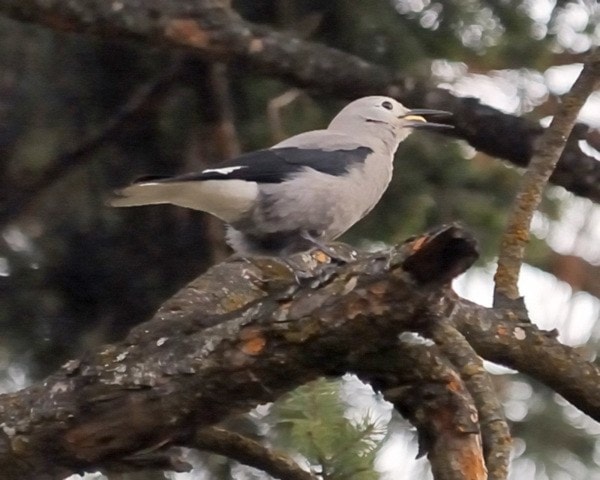Standing at the cabin window, I gazed at the area around the bird feeder thinking there were still plenty of seeds on the ground for the birds and the chipmunk. My gaze rested on an object with a somewhat familiar shape. But, was it a bird or was it a piece of bark? Whichever it was, it seemed to be lifeless. However, it called for closer scrutiny.
This “lifeless” object suddenly “became” a junco, whose back blended in perfectly with the forest litter background. There it sat, perfectly still with its head cocked to one side. All around, outside of the shelter of the cedar tree, snow was gently falling, creating another fresh blanket over the ground. The junco must have been thinking, “What is this? It's April! Here is new snow and my nesting spot is still covered by a foot of it.” The juncos, like other wildlife, will take it as it comes and hang in there.
This morning, April 7, after another fresh spread of snow, I was enjoying a brisk hike up the trail. Going was easy at first, but higher up the snow got a little deeper and, in the open areas, when my feet broke through the upper layers, I got some idea of how deep the snow really was. In the woods, there were bare areas but only under the trees. When almost to the brook where the snow was at least two feet deep on the trail, to my surprise, I heard the long clear whistle-call of a varied thrush. Being ground feeders, like their distant robin relatives, this swamp “robin” will keep going in spite of the snow by combining nourishment taken on in lusher wintering areas with scant morsels from the nearly frozen ground under the trees and along the brook. It just seemed out of place to me to hear that thrush with snow all around.
Every once in a while, I was breaking through the snow to nearly ground level. But the last evening footprint of a large cat that I spotted earlier on this morning jaunt was stopped in the upper levels of the snow. The spread toes help the cougar to stay more on the surface of the snow while the deer were breaking through to nearly ground level. In deep snow, the large wildcats have an advantage, while for the deer the going is harder, especially if there is a crust. But the deer can keep to the trees. When the snow goes, cougars, especially yearlings, will find food-finding more of a challenge.
Through the winter and spring, I have heard and seen more Clark’s nutcrackers than in other winters. Others have reported a similar trend. Few people have heard of this black, gray and white Steller’s jay-sized bird, let alone seen one. I am not sure how much of a “nutcracker sweet” it is with that long, straight, black bill meant for extracting seeds from those spiny ponderosa pine cones and cones of other pines. The Clark's nutcrackers, provided there is a good supply of pine nuts, fare well in winter because there food is seldom covered by snow. Perhaps a good supply of pine seeds the last couple of years accounts for so many sightings of adult birds. I find it hard to describe the call of a nutcracker, but since not many people know of this bird I feel safe in saying that one of its frequently given calls sounds like a nasal, raucous squawk. They had food-caching habits long before geocaching.
I am continually amazed at the numbers, diversity and timing of ways in which birds, insects and other forms of wildlife survive. The lives of birds are not carved in stone but have a large degree of versatility. Varied thrushes, whose return to nesting areas is not triggered primarily by the availability of food but the increasing length of day and so, when food is covered by snow, they will eat cracked corn. Robins, who stick around for the winter, or come back “too early” to find food and who are noted for their earthworm menu, will switch to frozen apples hanging in the orchard trees and to mountain ash berries. For the out there, the master plan is not of rigidity and set expectations but of flexibility and adaptability.
Ed McMackin is a biologist by profession but a naturalist and hiker by nature. He can be reached at 250-866-5747.
